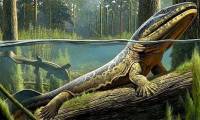
For the past 85 years, the coelacanth has been known as the

Ancient 'slow-living' fish Coelacanth with lifespan of up to a century and gestation period of five years, new study finds.

The sea monsters of the Devonian period are evidence of the evolutionary leap that enabled us to walk on continents today.

Tanyrhinichthys mcallisteri has a sturgeon-like shape with a long protruding snout that focuses the senses to help them catch prey.

Why do we have fingers, what does the number of these fingers mean in terms of evolution?

Fossils of ancient fish Tiktaalik roseae from about 375 million years ago show their fins shaped like the sole of the foot to be placed on the bottom of a river or stream.

The fish with unusually large eyes caught at a depth of 800 m in the sea made the fishermen panicked.

Archaeologists from Flinders University and Australian National University of Canberra have successfully reproduced the image of a strange fish that once inhabited an ancient coral

Prehistoric fossils found in China include bones with jaw characteristics of modern vertebrates.

The flat-headed, half-meter-long fish survive in the ocean of 92 million years ago by eating plankton.
 For the past 85 years, the coelacanth has been known as the
For the past 85 years, the coelacanth has been known as the Ancient 'slow-living' fish Coelacanth with lifespan of up to a century and gestation period of five years, new study finds.
Ancient 'slow-living' fish Coelacanth with lifespan of up to a century and gestation period of five years, new study finds. The sea monsters of the Devonian period are evidence of the evolutionary leap that enabled us to walk on continents today.
The sea monsters of the Devonian period are evidence of the evolutionary leap that enabled us to walk on continents today. Tanyrhinichthys mcallisteri has a sturgeon-like shape with a long protruding snout that focuses the senses to help them catch prey.
Tanyrhinichthys mcallisteri has a sturgeon-like shape with a long protruding snout that focuses the senses to help them catch prey. Why do we have fingers, what does the number of these fingers mean in terms of evolution?
Why do we have fingers, what does the number of these fingers mean in terms of evolution? Fossils of ancient fish Tiktaalik roseae from about 375 million years ago show their fins shaped like the sole of the foot to be placed on the bottom of a river or stream.
Fossils of ancient fish Tiktaalik roseae from about 375 million years ago show their fins shaped like the sole of the foot to be placed on the bottom of a river or stream. The fish with unusually large eyes caught at a depth of 800 m in the sea made the fishermen panicked.
The fish with unusually large eyes caught at a depth of 800 m in the sea made the fishermen panicked. Archaeologists from Flinders University and Australian National University of Canberra have successfully reproduced the image of a strange fish that once inhabited an ancient coral
Archaeologists from Flinders University and Australian National University of Canberra have successfully reproduced the image of a strange fish that once inhabited an ancient coral Prehistoric fossils found in China include bones with jaw characteristics of modern vertebrates.
Prehistoric fossils found in China include bones with jaw characteristics of modern vertebrates. The flat-headed, half-meter-long fish survive in the ocean of 92 million years ago by eating plankton.
The flat-headed, half-meter-long fish survive in the ocean of 92 million years ago by eating plankton.




 NASA's 'Ninth Planet' Shows Signs of Being Friendly to Life
NASA's 'Ninth Planet' Shows Signs of Being Friendly to Life Why did American astronauts have to be quarantined when returning to Earth?
Why did American astronauts have to be quarantined when returning to Earth? China surprises the world by building a cable-stayed bridge 'above the clouds'
China surprises the world by building a cable-stayed bridge 'above the clouds' Why do women sleep less and wake up more than men?
Why do women sleep less and wake up more than men? Revealing the secret inside the stuffed animal claw machine, from there, summarizing experience to help you increase your winning rate many times over
Revealing the secret inside the stuffed animal claw machine, from there, summarizing experience to help you increase your winning rate many times over What would happen if you dug a hole through the Earth and jumped in?
What would happen if you dug a hole through the Earth and jumped in? Camera takes a photo that lasts 1,000 years
Camera takes a photo that lasts 1,000 years Was there nuclear war in ancient times?
Was there nuclear war in ancient times?